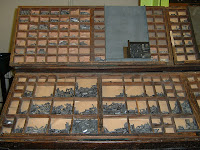“We’re living in the future.” – Orlando Cordero, roommate
“You need to be rich to live in the future.” – [yours truly]
The accident, as the sight of a new ontology, shows us something of the real—it shows us our own agency, removed from us, coming back to haunt us. We give up our own agency in the form of our creativity in favor of technoscience and the better, more convenient, more comfortable future that it promises. Investment in ‘objectivity’ promises that this future will be the same for us all.
In the case of Pruitt-Igoe, we want the future—an elegantly geometric future that expresses how far the old ontology of science has taken us. Unfortunately, that metaphysics is no longer relevant; we have to figure out a new future, and come to grips with the fact that the object will lead us there, co-opting our agency to bring itself & ourselves out of the present and further into the new metaphysics.
“Some called him a ‘pretext’. Others said he was a point-for-point microcosm.” – A Spokesman for the Counterforce
“That could be a building, that was so general.” – Ian Roberts, improv comic
In Pruitt-Igoe, the infinite exchangeability of the object—the commodity relationship of living in futurity, the desire for technoscientific utopia—breaks down and bites us like a carnivorous coffee table. Or, rather, it bit the lower-class residents who lacked capital and thus the capacity to consummate (after all, it is seduction) a range or variety of commodity relationships with different objects. The infinite repetition of living space fills in for the (missing) infinite exchangeability of capital.
The grid shows us a certain ideal, a world wherein everything is calculable and placeable, but this disregards the bending or deformation that is the grid’s force. This deformation is the accident—in Pruitt-Igoe, in Game Theory, the logical approach hits a breaking point. Instead of imposing the subjective logic of literacy’s metaphysics onto the object, we have to let the object dictate our new strategy.
En abyme, the grid subdivides itself into smaller and smaller increments, like the fine calculation of a curve, infinitely expandable and contractible. The golden spiral of Modulor is more poetic, and though we find this pattern in nature, Le Corbusier’s scale makes man the measure of all such objects. But what happens to these at Planck scale, when time and space purportedly break down?
“Man’s desires are limited by his perceptions; none can desire what he has not perceived.”
“He who sees the Infinite in all things sees God. He who sees the Ratio only sees himself only.”
- Blake, “There is No Natural Religion” [a&b]
The case of Watson, of Wolfram|Alpha, is the desire to bend the object to our will. Instead of letting the object speak in its own way, we want the object to speak to our own understanding. This seems like it will take us further from being able to ‘speak machine’ and grasp the accident as a sign, from being electrate. Not the fatality we’re looking for.
The image of graffiti on the bare walls of Pruitt-Igoe keeps coming back to me; the logical zero-sum game of funding left a blank canvas for inhabitants (not necessarily residents). If human and technological enetelchies are intertwined, this is the object co-opting us to bring it to ecstasy, to make it what it already is. Pruitt-Igoe replaced St. Louis slums with a vision of the future of architecture-as-human-habitat that came to be worse than what it replaced—more slum than slum.
The task now is to find the poetics of space. To liberate the image from the aqualitative grid and let it become artistic.
Of course, the only way out (past limit) is through (and on into ecstasis--abyme, Eternity, infinity).
“…in Eternity the Four Arts: Poetry, Painting, Music,
And Architecture which is Science: are the Four Faces of Man.
Not so in Time & Space: there Three are shut out, and only
Science remains thro Mercy: & by means of Science, the Three
Become apparent in time & space, in the Three Professions
Poetry in Religion: Music, Law: Painting, in Physic & Surgery:”
- Blake, Milton
Of course, the only way out (past limit) is through (and on into ecstasis--abyme, Eternity, infinity).
I've come across poetic renderings of self-referentiality (the cultural archetype or myth I've found) more than a few times: Blake does it obliquely on several occassions, and Mark Danielewski depicts it explicitly in House of Leaves when his protagonist finds a copy of the book itself; Shakespeare and Oscar Wilde make a similar gesture when they make play the subject of the play (in Shakespeare's case, it's usually overtly metatheatrical; Wilde is subtler). Being placed en abyme is what breaks mathematics (Godel and Principia) and machines (Euclid and the 216-digit number).
Mise en Abyme en Abyme : ^n+1 ?





















